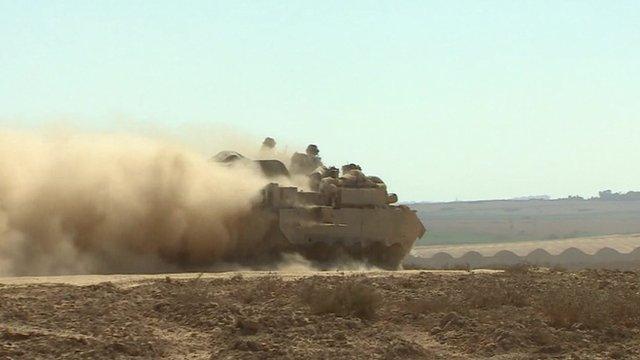Israel's operation in Gaza may be over, but no victor emerges
- Published

The Israeli military operation's death toll in Gaza has now surpassed that of Operation Cast Lead in 2008
With an uneasy truce that may or may not lead to an extended period of calm it is by no means clear that this episode is over.
Indeed in the absence of any fundamental change to the circumstances of Palestinians living in the Gaza Strip it may be just that - an episode in this brutal conflict - one that will be repeated in months or years to come.
It is already clear that there have been no winners. The Palestinian death toll has been widely condemned around the world as disproportionate. Israel has countered by insisting that many of Hamas's missiles and weapons stock-piles were located in inhabited areas and it argues that it has taken great pains to try to reduce civilian casualties as far as possible.
But seeking out targets in a densely packed area given the destructive power of air-launched weapons and modern artillery leaves little room for error. The number of UN installations hit inevitably raises questions about the margins of error and the ability to rapidly return fire in a discriminating manner.
In military terms there are clear lessons for both sides. Hamas, along with other Palestinian groups, has clearly learned from its previous clashes with Israeli forces.
Its fighters were well-trained and well-prepared. Its traditional weapon - long-range rocket-fire -proved much less successful than it might have hoped, given the performance of Israel's Iron Dome missile defences.
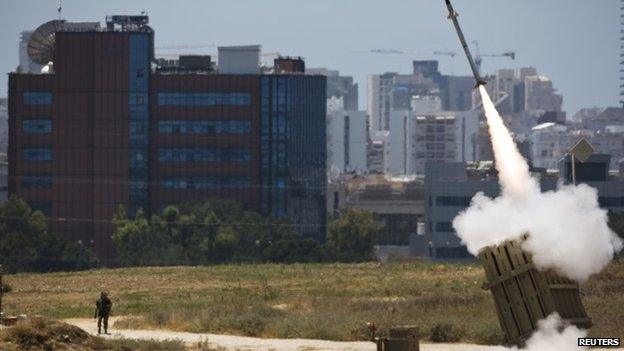
The Iron Dome missile shield has been credited with averting a larger civilian death toll in Israel
Iron Dome emerged again as a great success story. However it still has its critics who raise questions about its seemingly extraordinary success rate. Some locally-manufactured Hamas rockets may well be less effective and there are reports that some had a portion of their explosive removed to reduce weight and extend their range.
The rocket fire caused a small number of Israeli casualties. Rather more were caused by shorter-range mortar fire nearer the Gaza border. But the chief impact of the rockets was now, as always, disruptive - making normal life impossible as people rushed for the bomb-shelters.
Iron Dome did its job, not just in shooting some missiles out of the sky, but also, by reducing casualties, delaying the moment when Israeli leaders felt compelled to launch a military operation on the ground.
Hamas was nonetheless able to maintain a steady if intermittent barrage of missiles over the course of this conflict despite the onslaught from the Israeli Air Force and artillery.
According to Israeli intelligence estimates some 3,300 missiles were fired towards Israel. The Israel Defense Forces (IDF) claims to have destroyed some 3,000 more. Its assessment is that some 3,000 missiles are left in Gaza.

Israel has been criticised for targeting essential infrastructure in Gaza, such as power plants and hospitals
Sustaining the missile fire represents an achievement for Hamas though it may well have problems replenishing its arsenal given the hostility of the Egyptian government and the fact that many workshops in the Gaza Strip itself may have been destroyed.
Hamas's great innovation in this campaign was its use of tunnels (and indeed of small sea-borne units) to infiltrate Israel itself. It was Israel's interception of a group of fighters who had emerged from a tunnel in mid-July that prompted its ground operation whose chief mission was to locate and to destroy as many of the tunnels as possible.
But, as the Israelis found out to their cost, the tunnels were not perceived by Hamas solely as a means of infiltrating into Israel but as an integral element of the defence of the Gaza Strip itself. Hemmed into a relatively small and largely built-up space, Hamas literally sought strategic depth by digging and tunnelling, creating a maze of underground corridors with multiple access points.
This was the three-dimensional battlefield into which Israeli ground forces advanced.
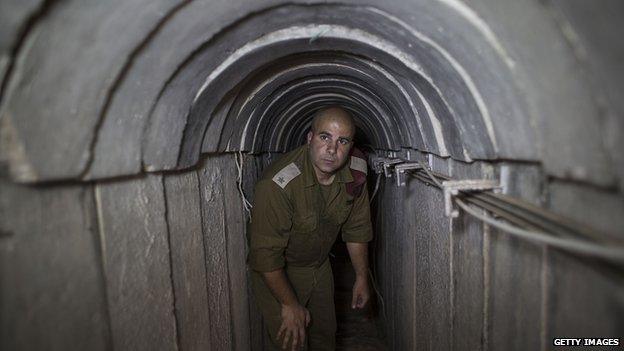
Israel claims to have destroyed all of the Hamas tunnels but say that troops will still be stationed near Gaza
Inevitably there were blunders. Israeli analysts were quick to condemn the use of the relatively ancient and vulnerable M-113 personnel carrier - one of which was destroyed with multiple casualties. But it was the tunnels that seemed to give the Israelis most problems. It was not so much that the tunnels were a surprise. Indeed some had already been located by Israeli intelligence and the troops made their way to them rapidly.
The problem for the IDF was more that it had not assimilated the wider significance of the tunnel network or trained sufficiently to deal with it. Many of its casualties were caused by the bitter fighting in built-up areas with Palestinian fighters rapidly emerging from hiding and then disappearing again underground.
One Israeli commentator, external likened the tunnel problem to that posed by Egyptian anti-tank missiles which devastated Israeli armour in the early stages of the 1973 war. Israel knew about the weapons; it saw the Egyptians training intensively with them; but it did not comprehend their broader operational significance.
Hamas had clearly learnt lessons from the last major Israeli incursion into the Strip. Israel, it appears, thought that this time would be something of a re-run of its previous rapid success in which it incurred far more limited casualties. The 64 IDF deaths are significant given Israel's military culture and there will inevitably be questions asked about the genesis and conduct of the campaign.
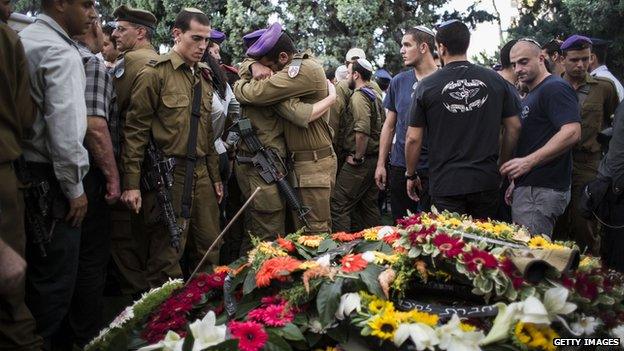
Despite the deaths of 64 IDF soldiers, the operation is supported by most of the Israeli public
Conflicts like the Gaza crisis are frequently described as asymmetric in the sense that they do not pitch together two equal or similarly equipped adversaries but two very different opponents with different skills and in this case vastly disproportionate levels of fire-power. But there was something fundamentally asymmetric about the goals of this operation as well.
For the Israeli Prime Minister Benjamin Netanyahu the aims were essentially tactical - to achieve "quiet for quiet" - and to neutralise the tunnels as far as possible. Israeli commentators have criticised Mr Netanyahu for having no real strategic vision and for effectively signalling to Hamas leaders that their destruction was not Israel's preferred outcome.
Like the US and its allies in Iraq and Afghanistan, Israel is rapidly learning that the utility of overwhelming force in an asymmetric conflict is circumscribed, not least when its opponents' military infrastructure is buried in civilian areas and Israel's international standing is on trial.
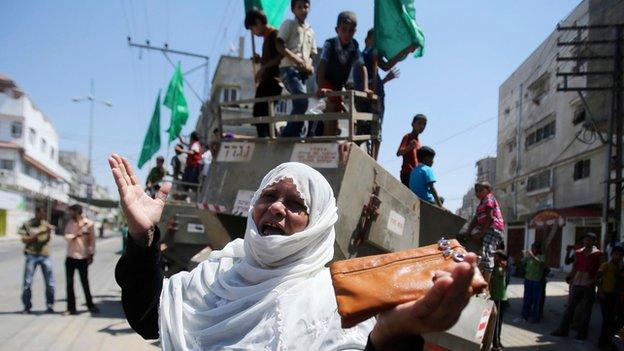
The Israeli military operation's death toll in Gaza has now surpassed that of Operation Cast Lead in 2008
For its part Hamas set out to sacrifice its hard-to-accumulate military assets - its rockets and tunnels - years of work - for an altogether more strategic aim. It wanted in some way to alter the situation in Gaza and to lift what it sees as a continuing siege of the territory.
Hamas knew that this strategy could lead to numerous civilian casualties. Perhaps it bargained on international opinion bearing down upon Israel sooner to get it to halt its offensive. If so it was a high-risk strategy and at this stage it is by no means clear that the level of death and destruction is necessarily going to lead to a fundamental shift in Gaza's circumstances.
Few of the regional actors seem willing to take risks for peace and with ongoing dramas in Gaza, Syria and Iraq, there is a broader weariness with the region with one leading US commentator describing the state of the Middle East as something akin to that of Europe during the Thirty Years War.
- Published7 August 2014
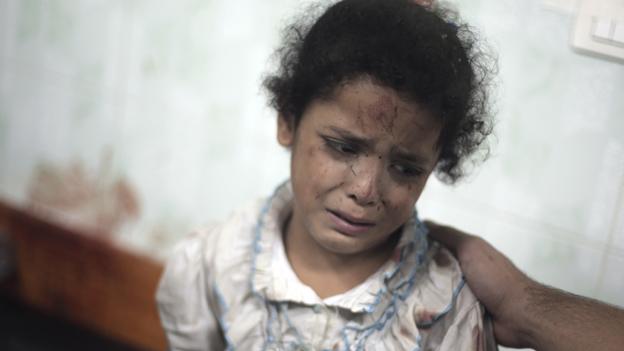
- Published5 August 2014

- Published3 August 2014
